The Tale of Custard the Dragon - 1 Summary Class 10 English First Flight Chapter 9
| Table of contents |

|
| About the Poet |

|
| Key Points of the Poem |

|
| Detailed Summary |

|
| Theme/ Message |

|
| Literary Devices |

|
| Difficult Words |

|
About the Poet
Ogden Nash, born on August 19, 1902, in New York, initially worked as a school teacher before transitioning to a career as a copywriter. He began publishing poems in "New Yorker" magazine in 1930, with his first collection, "Hard Lines," released in 1931. Some of his notable books include "The Boy Who Laughed at Santa Claus" (1957) and "Girls Are Silly" (1962). Nash is most famous for his nonsensical poetry. He passed away on May 19, 1971.
Key Points of the Poem
- The story of Custard the dragon is a humorous ballad about a timid dragon who is the pet of Belinda, a little girl living in a white house with her other pets: Ink the kitten, Blink the mouse, Mustard the dog, and Custard the dragon.
- While the other pets are described as brave and compared to animals like bears, tigers, and lions, Custard is portrayed as very timid, always seeking safety. Despite being teased by the others, Custard surprises everyone by bravely confronting and defeating a pirate who enters the house one night.
- Grateful for Custard's bravery, the other pets thank him, realizing they underestimated him. The poem teaches that sometimes the most timid individuals can be heroes in tough situations.
Detailed Summary
1st Stanza
Belinda lived in a little white house,
With a little black kitten and a little gray mouse,
And a little yellow dog and a little red wagon,
And a realio, trulia, little pet dragon.
The opening stanza of the poem introduces the characters residing in Belinda's little white house. Along with Belinda herself, four pets inhabit the house, comprising a black kitten, a small grey mouse, a petite yellow dog, and a diminutive dragon. Additionally, Belinda possesses a red wagon among her belongings.
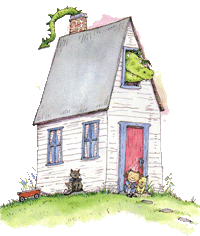
2nd Stanza
Now the name of the little black kitten was Ink,
And the little gray mouse, she called her Blink,
And the little yellow dog was sharp as Mustard,
But the dragon was a coward, and she called him Custard.
Belinda affectionately named her small black kitten "Ink" and her tiny grey mouse "Blink." The dog's coat boasted a vibrant shade of yellow, reminiscent of the condiment mustard. However, unlike Belinda's other pets, her dragon, named Custard, was distinctly lacking in bravery, often displaying cowardly tendencies. Despite his timid nature, Custard remained a beloved member of Belinda's household.
3rd Stanza
Custard the dragon had big sharp teeth,
And spikes on top of him and scales underneath,
Mouth like a fireplace, chimney for a nose,
And realio, trulia, daggers on his toes.
This stanza describes the dragon. Custard’s physical appearance. He carried all the features of a dragon that could make him powerful, scary and brave. It had big sharp teeth and spikes on its back that could easily scare anyone away. Custard also had the ability to spit fire which makes his mouth like a fireplace and thus his nose became a chimney. His toes were so pointed and sharp that could cut anything like a dagger.
4th Stanza
Belinda was as brave as a barrel full of bears,
And Ink and Blink chased lions down the stairs,
Mustard was as brave as a tiger in a rage,
But Custard cried for a nice safe cage.
This stanza provides a vivid description of each member of Belinda's household. Belinda herself is depicted as possessing immense courage, likened to the bravery of numerous bears combined, drawing a comparison to the formidable strength of a tiger. In contrast, Custard, the dragon, is described as being completely opposite to his intimidating physical appearance, indicating his lack of bravery despite his fearsome exterior. The description of Ink and Blink, the kitten and mouse respectively, highlights their ability to deter even the strongest adversaries, as powerful as a lion. However, Belinda's dog is portrayed as lacking in bravery, preferring the security of a safe cage rather than confronting danger. Despite their varying levels of courage, each member of the household plays a unique role in the narrative, contributing to the dynamic and diverse cast of characters.
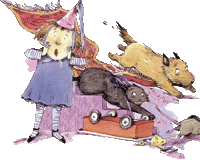
5th Stanza
Belinda tickled him, she tickled him unmerciful,
Ink, Blink and Mustard, they rudely called him Percival,
They all sat laughing in the little red wagon,
At the realio, trulia, cowardly dragon.
In this stanza, Belinda engages in a playful interaction with Custard, the dragon, by tickling him in what is described as a rather cruel manner. Despite Custard's timid nature, Belinda's actions provoke a reaction from him, eliciting laughter from the other characters, including Ink, Blink, and Mustard. The dragon, affectionately named Percival by Belinda's other pets, responds to the tickling with visible amusement, which in turn amuses the rest of the group. Their laughter fills the scene as they all sit together in Belinda's red wagon, enjoying the lighthearted moment created by the playful interaction with the normally timid dragon. This stanza captures the joyful camaraderie among the characters and highlights the whimsical nature of the poem.
6th Stanza
Belinda giggled till she shook the house,
And Blink said Week!, which is giggling for a mouse,
Ink and Mustard rudely asked his age,
When Custard cried for a nice safe cage.
Belinda found the dragon amusing and laughed heartily at it. Her laughter was so loud that it seemed to shake the dragon. Blink, the mouse, made a giggling sound, expressing its amusement. Ink and Mustard, likely other characters, mocked the dragon by asking its age, implying that it behaved childishly. However, the dragon, named Custard, only desired a secure and comfortable enclosure for itself.
7th Stanza
Suddenly, suddenly they heard a nasty sound,
And Mustard growled, and they all looked around,
Meowch! cried Ink, and Ooh! cried Belinda,
For there was a pirate, climbing in the winda.
As the members of the household continued to mock Custard, an unexpected disturbance interrupted their amusement. Mustard, the dog, responded with a growl, indicating alertness and readiness to investigate the source of the noise. Ink, presumably a cat, expressed distress with a "Meowch," while Belinda reacted with surprise and concern, exclaiming "Ooh," as they all noticed a pirate climbing through the window with the intention of robbing the house.
This sudden turn of events shifts the focus from the lighthearted teasing of Custard to a more serious and potentially dangerous situation. The appearance of the pirate introduces an element of tension and danger, prompting the characters to respond with alarm and vigilance. The abrupt change in tone highlights the unpredictability of the narrative and adds suspense to the story.
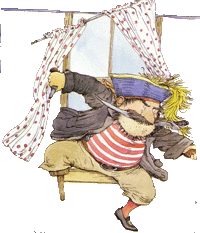
8th Stanza
Pistol in his left hand, pistol in his right,
And he held in his teeth a cutlass bright,
His beard was black, one leg was wood,
It was clear that the pirate meant no good.
The pirate appeared menacing and threatening, as he was armed with multiple weapons. He wielded pistols in both hands and clutched a sharp blade between his teeth, indicating his readiness to engage in violence. His physical appearance, characterized by a black beard and a wooden leg, added to his intimidating demeanor. The pirate's demeanor and gestures left no doubt that he intended to cause harm to both the house and its occupants.
9th Stanza
Belinda paled, and she cried, Help! Help!
But Mustard fled with a terrified yelp,
Ink trickled down to the bottom of the household,
And little mouse Blink strategically mouseholed.
Upon seeing the pirate, Belinda was overcome with fear and visibly paled, crying out loudly for assistance. In a sudden panic, all her loyal pets deserted her. Mustard, the dog, cried out in distress and hastily fled from the scene. Ink, the cat, retreated silently to the lower part of the house, seeking safety. Blink, the clever mouse, swiftly vanished into a mouse hole, leaving Belinda completely alone and vulnerable in her distressing situation.
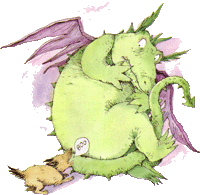
10th Stanza
But up jumped Custard, snorting like an engine,
Clashed his tail like irons in a dungeon,
With a clatter and a clank and a jangling squirm,
He went at the pirate like a robin at a worm.
When the other pets retreated into hiding, it was Custard, the timid dragon, who bravely stepped forward to confront the pirate. Despite his usual cowardice, Custard leaped in front of the pirate and emitted loud, aggressive noises akin to the roar of an engine, fueled by anger. His movements echoed throughout the room, producing clattering sounds reminiscent of an iron rod striking the walls of a dungeon. With his intimidating display, Custard pursued the pirate closely, mirroring the determined pursuit of a robin tracking its prey.
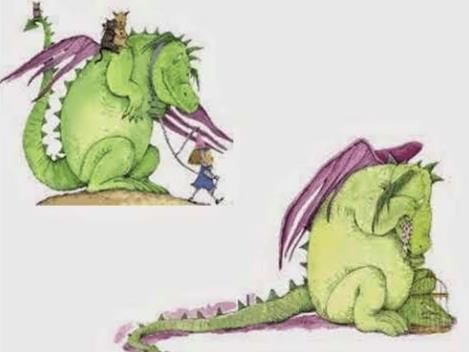
11th Stanza
The pirate gaped at Belinda’s dragon,
And gulped some grog from his pocket flagon,
He fired two bullets but they didn’t hit,
And Custard gobbled him, every bit.
The pirate was shocked to see Belinda’s dragon, He gaped at him and drank some wine from a bottle that he carried in his pocket. The pirate then took out his pistol and fired two bullets at Custard. But he failed to hit him and Custard was unharmed. Then Custard swallowed the whole of the pirate, without leaving any trace of him.
12th Stanza
Belinda embraced him, Mustard licked him,
No one mourned for his pirate victim,
Ink and Blink in glee did gyrate,
Around the dragon that ate the pirate.
The sight of Custard devouring the pirate left everyone astonished, filling the house with joyous relief. Belinda, overwhelmed with gratitude for Custard's heroic act, embraced him tightly. Mustard, expressing his affection, licked the dragon affectionately. The entire household rejoiced in the demise of the pirate, celebrating with shared happiness. Ink and Blink, caught up in the jubilant atmosphere, began dancing joyfully around Custard as a gesture of elation.
13th Stanza
But presently up spoke little dog, Mustard,
I’d have been twice as brave if I hadn’t been flustered.
And up spoke Ink and up spoke Blink,
We’d have been three times as brave, we think,
And Custard said, I quite agree
That everybody is braver than me.
After the pirate incident, it was quite clear who was brave and who was coward. But, Mustard gave an excuse for his cowardice and said that he would have been twice as brave as Custard if he had not got nervous; when the pirate came. Ink and Blink said that they would have been thrice as brave as the dragon. They started giving excuses for their running away. The humble dragon accepted that he was the most coward and everyone was braver than him.

14th Stanza
Belinda still lives in her little white house,
With her little black kitten and her little gray mouse,
And her little yellow dog and her little red wagon,
And her realio, trulio, little pet dragon.
In the beginning stanza of the poem, the characters of the poem are introduced. They are: Belinda, who lived in a little white house with her pets and a wagon. Her pets include a black kitten, a little grey mouse, a little yellow dog and a little dragon.
15th Stanza
Belinda is as brave as a barrel full of bears,
And Ink and Blink chase lions down the stairs,
Mustard is as brave as a tiger in a rage,
But Custard keeps crying for a nice safe cage.
In this stanza, the characteristics of each member of the household are described. Belinda's remarkable courage is likened to that of a tiger, surpassing the bravery of many bears combined. However, Custard, despite his fearsome appearance, possessed a timid and timid demeanor, contrasting with his physical stature. Ink and Blink were depicted as having the ability to frighten away even someone as formidable as a lion. Despite Belinda's dog's lack of bravery, he constantly sought the comfort and security of a safe cage.
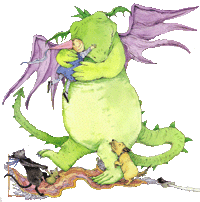
Theme/ Message
Theme
- The poem is based on the theme that appearances are deceptive. It brought forth the fact that the assessment of people about themselves and others is not always true.
- Belinda and her pets Ink, a kitten, Blink, a grey mouse and Mustard, a yellow dog have a poor opinion of Custard, the dragon, who is ridiculed as a coward. However, when they have to face a pirate, their true characters prove to be contrary to their claims.
- It is only Custard who was ridiculed as a coward came forward and gave a fierce fight to the pirate and rescued the so-called brave Belinda and her pets.
Message
- The poem conveys the message that appearances are deceptive and we must not judge people from their appearances or on their own claims. In times of adversity, only a true evaluation of a person can be made.
- Another message that this poem gives is that those who are really brave, need not boast of their bravery and their mettle is proved only when they encounter a dangerous situation.
Literary Devices
- Rhyme scheme: The rhyme scheme of the poem is ‘aabb’. However, for stanza 13, the rhyme scheme is aabbcc.
- Ballad - The poem is in the form of a ballad – a long poem usually set to music. The poet Nash uses this form to narrate the tale of Custard the dragon and how he defeats a pirate.
- Simile - Simile is a poetic device used by the poet to draw a clear comparison between two or more things or people with the help of words ‘like’ and ‘as’.
The phrases – ‘sharp as Mustard’, ‘mouth like a fireplace’, ‘as brave as a barrel full of bears’, ‘brave as a tiger in a cage’, ‘snorting like an engine’, and ‘clashed his tail like iron in a dungeon’ pirate like a robin – are examples of simile in the poem.
Through this device, Nash creates humorous descriptions of the characters in the poem. - Metaphor - A metaphor is a literary device used to represent a comparison without using the words “like” or “as”.
chimney for a nose
And realio, trulio daggers on his toes - Repetition - The poet uses repetition at various points in the poem to create a rhythmical effect in the poem. He also uses it to build humour in the poem.
For example, the word ‘little’ has been repeated multiple times in the first two stanzas.
Similarly –
Belinda tickled him, she tickled him unmerciful.
Suddenly, suddenly they heard a nasty sound.
Pistol in his left hand, pistol in his right - Onomatopoeia - This poetic device is used by the poet to describe the sounds produced with the help of the words. It uses the sound-descriptive words like ‘hiss’, ‘bang’, ‘splash’, etc.
The word ‘weeck’ is an example of onomatopoeia in the poem. It mimics the sound of a rat’s giggle.
Similarly, ‘Meowch’ for cat’s sound
Similarly, the words ‘clatter’, ‘clank’ and ‘jangling’ are examples of onomatopoeia in the poem. - Poetic License - When a poet disregards the rules of language, he uses poetic license in his works.
The words ‘realio’, ‘trulio’ and ‘weeck’ are made up words that Nash uses to impart humour to the poem. Through this, he practises poetic license. Also, he has changed window to ‘winda’ to maintain the rhyme scheme of the poem. - Alliteration - Alliteration is the repetitions of the same sound used in the beginning of the closely placed words.
The line ‘Belinda is as brave as a barrel full of bears’ is an example of alliteration in the poem.
Other examples –
Belinda lived in a little white house.
And he held in his teeth a cutlass bright.
With a clatter and a clank and a jangling squirm.
And gulped some grog from his pocket flagon. - Allusion - An allusion is an indirect reference to a person, place, thing, and idea. In the poem, the characters make fun of Custard by calling him ‘Percival’. Percival was one of King Arthur’s knights who was known for running away due to lack of courage.
Thus, the characters call Custard ‘Percival’ because they consider him a coward. - Irony - In the poem, Nash has used irony to show that while Belinda and her pets considered themselves brave, they ultimately ran from the pirate. Also, though Custard cried for a cage, in the end he bravely confronted the pirate.
Difficult Words
- Wagon: A small vehicle used for transporting goods and people
- Realio Trulio: A twisted form of really truly
- Trivial: Not very important
- Deliberately: Doing something knowingly
- Cosiness: The warmth and peace that one gets when they are relaxed
- Mortal enemies: Enemies for a long time
- Spikes: A thin pointed piece
- Barrel: A cylindrical container made to store things
- Daggers: Pointed swords
- Rage: Anger at the extreme
- Heinous: Utterly wicked
- Mythical: Fictitious, with reference to the past
- Growl: Make a low sound
- Winda: Colloquial for window
- Cutlass: A short sword with a curve at the end
- Dungeons: A strong underground passage
- Clattering: A continuous rattling sound
- Squirm: Twist the body
- Gaped: To open one's mouth in shock
- Flustered: To make someone nervous
- Glee: Very happy
- Gyrate: Move rapidly in circles
|
61 videos|620 docs|69 tests
|
FAQs on The Tale of Custard the Dragon - 1 Summary Class 10 English First Flight Chapter 9
| 1. What is the main theme of "The Tale of Custard the Dragon"? |  |
| 2. Who are the main characters in the poem? |  |
| 3. How does Custard the Dragon demonstrate bravery in the poem? |  |
| 4. What literary devices are used in "The Tale of Custard the Dragon"? |  |
| 5. How does the poem challenge stereotypes about bravery? |  |
















